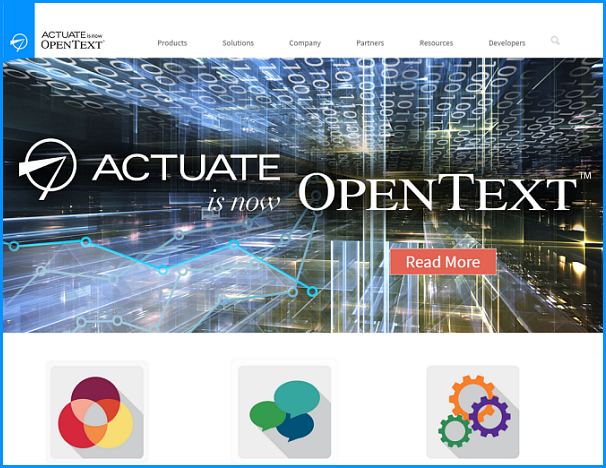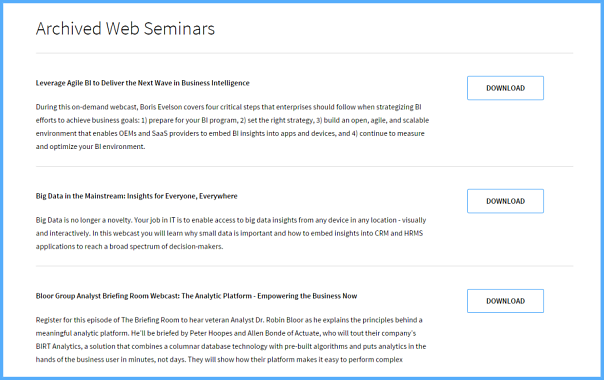by
David Kirkpatrick, Reporter
Webinars can be very effective tools in the B2B marketer's toolbox for generating leads. They can also be utilized as a registration tool for high-level informational webcasts and as key content pieces to move prospects down the funnel with more targeted presentations that fit into an overall lead nurturing and content strategy.
At the same time, webinars and webcasts have an added layer of challenge as a content piece compared to a blog post, white paper or even an infographic or video because there is a technical element to the live online event. Registrants have to be able to successfully log into the webinar to view it live, and there are other elements to consider such as interactivity between viewers and presenters.
Actuate, an embedded analytic software company, has a marketing programs group within the marketing division. That group executes webcasts at around 50% of its programs, counting both webinars and live demos via Sales.
Actuate was recently acquired by OpenText, although it still operates relatively independently as the company becomes more fully integrated with OpenText.

Click here to see the full version of this creative sample
THE CUSTOMER
According to Helaine de Tomasi, Director of Marketing Programs, Actuate, the company provides "business analytics and intelligence and visualization dashboards that turn big data into information and insights."
Key industries for Actuate include financial services, manufacturing, government and telecommunications. According to de Tomasi, the company serves enterprise-level businesses but has an offering for smaller businesses as well. In reaching these markets, Actuate's marketing is geared toward developers and IT managers, who actually use the tools, and, for decision-making purposes, mid-management and executive management professionals with a holistic overview of their company's IT organization.
De Tomasi explained the two different target audiences: "The developers are using the tools so they're definitely influencing that piece of [buying], but for purchasing, it's really more of a business decision maker."
CHALLENGE
The team at Actuate had previously been utilizing a different vendor for its webinars but wasn't satisfied because of a number of issues, including:
- Frequent conference number issues
- No branding and console customization options
- Limited webcam capabilities
- Lack of integration with the Salesforce platform
- Inadequate social media capabilities
Another issue was that the previous platform didn't allow for Actuate to stream from its in-person events — something that wasn't a problem until bad winter weather radically impacted the number of attendees at a series of live events across the Northeast. Based on responses from registrants for these events, the company learned attendees wanted an option to attend virtually.
De Tomasi also said she had been brought into Actuate to rebuild the team and the existing organization, including IT. She was also responsible for rebuilding processes and technology pieces, such as software.
She realized the existing webinar platform had limited features and knew of another platform that not only offered more features the team wanted, but also would integrate with some of the other software pieces that she was adding as part of the overall rebuilding effort within the group.
CAMPAIGN
Along with de Tomasi joining Actuate to rebuild the group, around the time of the switch to the new webinar platform another member, Linda Maniphone, Marketing Event Specialist, Actuate, was added to the team. Maniphone said she came in with no background in creating and moderating webcasts, so she was able to learn the new platform from a fresh perspective.
The team at Actuate undertook this effort to overcome challenges it faced with a previous webinar vendor and, in doing so, found new capabilities with its new vendor, allowing the team to increase its use of webcasts in the marketing strategy.
Step #1. Understand the desired webinar platform features
According to de Tomasi, at the basic level, the team wanted to run webinars, simulcast live events, provide Sales with an avenue for online demos and create a library of recorded online events.
"We wanted to have a library of webcasts where the audience could go in and view webcasts that were on-demand," she said.
Another key point was dependability.
De Tomasi explained, "We just needed a platform where both the users and the presenters, and the Q-and-A moderators, really weren't going to have any technical difficulties that took time out of our webcast."
Through the new platform, the team was able to increase the number of webinars produced, while keeping almost all of the attendees at the webcast for the duration due to added engagement. Real-time polling questions were added into the online event, and results were shared in real-time, which sparked engagement and encouraged conversation among attendees.
Step #2. Increase the number of online events
The new webinar platform with the team's desired features went hand-in-hand with Actuate's strategy of increasing the number of online events and building content. De Tomasi said an important part of the strategy was increasing the number of webcasts on solutions and thought leadership.
To encourage viewers to attend a more-crowded webinar schedule, the subscriber database was sent newsletters, and the email campaign lists were segmented by criteria such as:
- Interests
- Audience persona of the industry
- Job title
- Product covered in the webinar
De Tomasi provided an example of how the team segmented its list for particular webcasts.
"We did a webcast … based on a Gartner conference session, and we overlaid their four pillars of business analytics with our products to see how we aligned and how we addressed each pillar. We knew the audience level was going to be a management solution where they were looking to see, 'How do you align with Gartner? How does your product fit into the solution?,'" she said.
De Tomasi added, "We wanted to pull a list of upper management that we knew had an affiliation with Gartner, and we were able to segment that out."
Step #3. Support Sales with webinar product demos
De Tomasi said the team actually reports to Sales, so Actuate has a high level of Marketing and Sales alignment.
She described the relationship, saying, "There's a hand-off process we've established, and we meet with them on a regular basis, just to hear more about what are the prospects asking for. What are they looking for? What are their challenges for that? Then we could go back and create programs that have those topics — that cover them — so we can market it to the contacts."
De Tomasi was sitting on a management call focused on the number of demos the sales team and sales engineers could work on throughout the week. That number was limited because the demos were very resource-intensive.
She said, "I thought about, 'How do we address this for that?' We, perhaps, have a bi-weekly live demo. It's not going to be customized, but it's going to be just a product demo where we can show the attendees an overview of the product."
Once the online demos launched, the team realized there was a pent-up demand after having over 200 registrants for the initial event with 150 actually attending. De Tomasi said the team has remained consistent with the bi-weekly demo schedule with over 100 registrants for each event. She added that the team learned from their customers that, even when there is one registrant, sometimes more actually view the event. One customer reported 17 people actually viewing the demo from one company's registration.
The demos themselves were conducted live by a senior director of sales, and the event itself was essentially a half hour focused on the product, explaining: "What does it do? What are the features and solutions?" The demos also feature a live Q-and-A with the attendees.
After each demo, the team automated a follow-up email customized for each program. For lead nurturing, about a month later, both attendees and registrants who did not attend received an on-demand link for the demo and possibly another featured webcast.
Step #4. Build a video library from webinar content
The goal of creating a
video library of Actuate's webinar content was to simplify finding that content for website visitors.

Click here to see the full version of this creative sample
The library was segmented by product lines, so when someone would receive a nurturing email sending them the library on on-demand webcasts, it would be targeted for a specific product line.
De Tomasi said this improved the user experience because "they don't have to go through a long list and do a search or segment out which ones are for the enterprise. That's already completed for them."
She added the library is also utilized in customized email campaigns by highlighting featured webcasts with unique URLs.
"We can pull out maybe some of our featured webcasts per segment of an audience," de Tomasi said. "Perhaps they're in the financial service space and select the featured webcast that we think will resonate with them. Or if they're in government, we can have an email campaign and send them to a portal that just shows the webcasts that are relevant to them."
RESULTS
One result of the effort was readily apparent — a dramatic increase in the number of webinars the team was producing.
De Tomasi said when she joined Actuate "they might have had two or three webcasts a quarter, whereas now we probably have about four or six per month. And we're just adding new contacts to our database."
Some of the metrics include:
- A 25% increase in new contacts from the bi-weekly product demos
- A 65% registration to attendee rate for the demos
- A 50% increase in webinar viewer time as compared to previous webinar platform
- Almost 90% of webinar attendees stay for the entire event
De Tomasi said this effort showed the importance of investing in "the right tools that are a good fit for your marketing programs."
Looking toward the future of the webinar program at Actuate, de Tomasi said the team is expecting to add social media widgets for attendees to make social sharing easy from within the platform.
Creative Sample
- Homepage
- Acuate's video library
Sources
ActuateOpenTextON24 (Actuate's webinar vendor)
Related Resources
Register for the next MarketingExperiements Web clinic, "Harnessing Customer Motivation"Webinar Marketing: Adobe revamps strategy and achieves a 500% lift in conversion to saleContent Marketing: Webinar strategy increases registration, lead capture 91%Email Marketing: 400% webinar attendance increase for B2B company through relevance and A/B testingB2B Webinars: How HubSpot drew 25,000 sign-ups, almost 10,000 attendees, and more than 3,500 new leads











